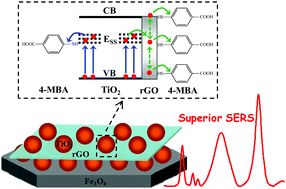Metal-free SERS substrate based on rGO–TiO2–Fe3O4 nanohybrid: contribution from interfacial charge transfer and magnetic controllability†
Abstract
The exploitation of new types of non-metal surface-enhanced Raman scattering (SERS) substrates with high performances and the exploration of enhancement mechanisms are of vital importance for the development of the SERS technology due to its potential prospects in both the spectroscopy and material fields. Here, a magnetic SERS-active substrate hybridized by reduced graphene oxide (rGO), TiO2 and Fe3O4 (rGO–TiO2–Fe3O4) was successfully prepared via the combination of a simple sol-hydrothermal method and a co-precipitation method. The as-synthesized rGO–TiO2–Fe3O4 nanohybrid not only exhibited outstanding SERS detection ability with high sensitivity and spectral reproducibility, but also could be recycled with high stability based on its self-cleaning capacity and magnetism. Exploiting these features, it could be used for the SERS detection of 4-mercaptobenzoic acid (4-MBA), 4-mercaptopyridine (4-MPy), 6-mercaptopurine monohydrate (6-MP), 1,2-di(4-pyridyl) ethylene (BPE) and p-aminobenzoic acid (PABA) with the detection limits of 1.0 × 10−10, 1.0 × 10−8, 1.0 × 10−10, 1.0 × 10−10 and 1.0 × 10−9 mol L−1, respectively; these are the highest SERS sensitivity values among those reported for semiconductor substrates and are even lower than that of noble metal substrates. Meanwhile, an SERS enhancement mechanism from the synergistic effects of the rGO, TiO2 and Fe3O4 components was proposed to explain the observed considerable SERS enhancement on rGO–TiO2–Fe3O4.

- This article is part of the themed collection: 2019 PCCP HOT Articles


 Please wait while we load your content...
Please wait while we load your content...